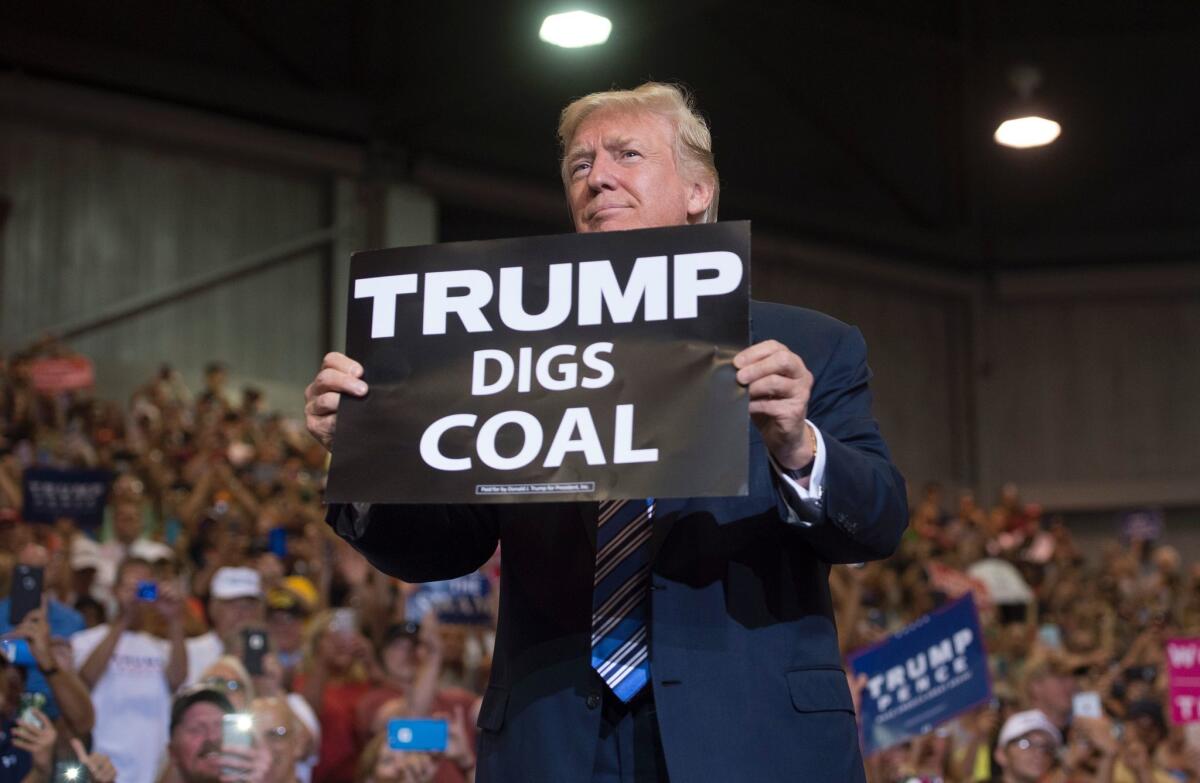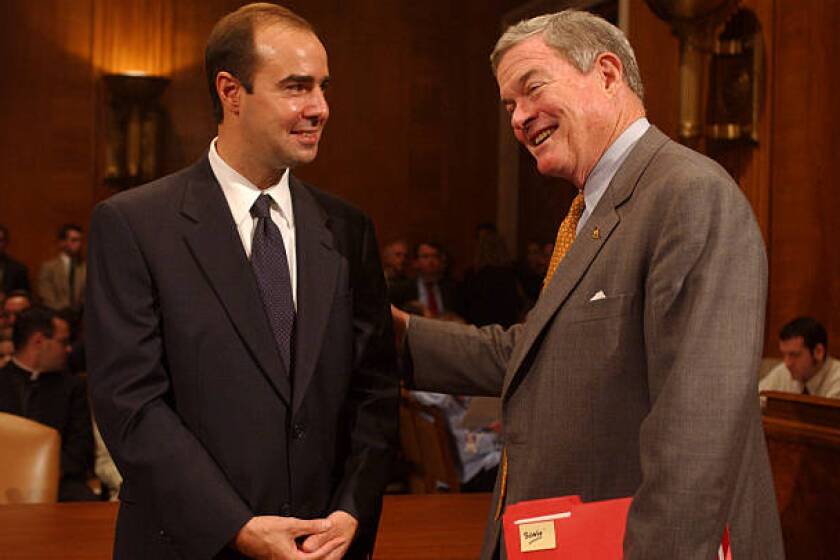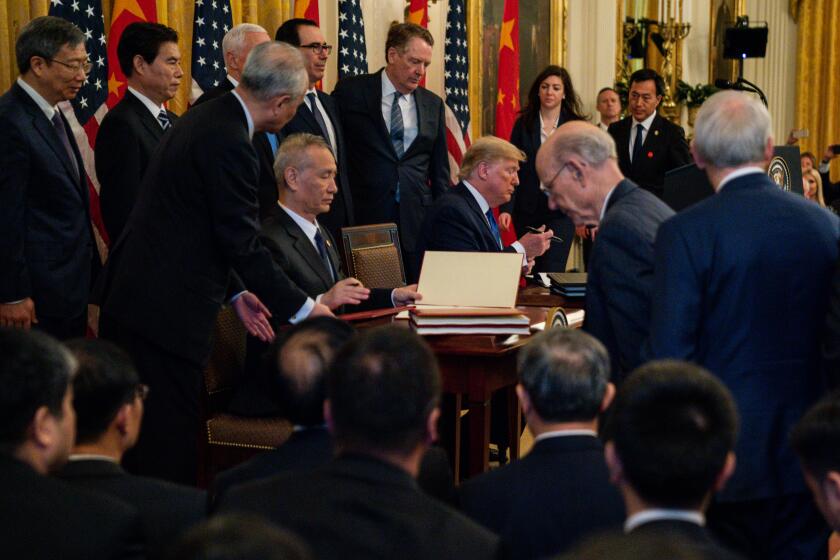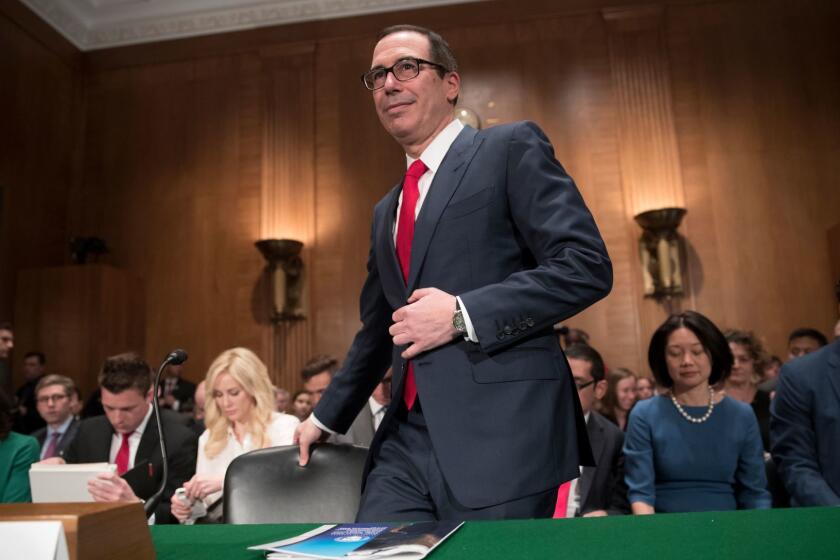Column: Trump says the economy is doing great — but whose economy is it?

President Trump and his economic advisors have been taking a rather premature victory lap about the nation’s economic performance during his three years in office.
It’s premature in part because Trump’s term isn’t over yet. And also because the economy hasn’t performed nearly as well as he says, even if one discounts a good portion of his rhetoric as bombast.
In his State of the Union address earlier this month, Trump proclaimed the economy to be “the best it has ever been.”
No one’s going to argue with the point that coal, as a percentage of U.S. electricity generation, is declining and will probably continue to decline for some time.
— Energy Secretary Dan Brouillette
In the foreword to the latest report from his Council of Economic Advisors, released Thursday, Trump boasts of having “championed policies to restore the United States’ economic strength... including tax cuts, deregulation, energy independence, and trade renegotiation.”
The report itself, however, acknowledges that as of December the U.S. economic expansion had reached its 127th month, meaning that it began 7 1/2 years before Trump took office.
As for his assertion that his economy is the best in U.S. history, the rationale for that claim is a mystery. It’s not true by any measure.
Trump’s evisceration of labor protections will continue under Labor Department nominee Scalia
Much of Trump’s economic rhetoric is aimed at the Obama administration by asserting, as he does in the latest White House economic report, that he has reversed “trends seen under the previous administration.”
(He may have been goaded by a tweet issued by Obama on Feb.17 marking the 11th anniversary of the American Reinvestment and Recovery Act. Obama tweeted that the act had paved the way “for more than a decade of economic growth and the longest streak of job creation in American history.”)
With Trump’s tenure entering its fourth year, evidence is mounting that the economic expansion under his leadership has left millions of Americans behind. The government’s own statistics demonstrate that large sectors of the economy — including those for which Trump is making especially bold claims — aren’t performing well at all.
They include coal mining, which appears to have become bound in an implacable doldrums since 2016, and manufacturing, which entered a recession late last year and in which employment has, at best, stagnated.
As we’ve reported before, Trump’s campaign promise of driving the economy to a growth rate of more than 3% has receded into the mists of time. The president’s economic report projects real annual growth (net of inflation) of about 3.1% this year, falling to about 2.8% toward the end of the decade.
But that’s only with “full implementation” of Trump’s economic agenda of further business deregulation and an extension of the tax cuts enacted in December 2017, which were heavily tilted toward the wealthy. Barring that, the economic team says, annual growth could fall to just over 2% a year.
The stock market has been soaring, but even the biggest gain in the Standard & Poor’s 500 of the Trump years — the 31.1% gain last year — didn’t match the best year under Obama, a 32.43% gain in 2013.
The index never had a negative year during Obama’s eight years in office, incorporating dividends, but already has had one (2018) under Trump. After selloffs Monday and Tuesday, both the S&P 500 and the Dow Jones industrial average turned negative for 2020.
Column: California’s dairy farmers were struggling to regain profitability. Then came the trade wars
“The overall feeling is that we hit ‘peak cow’ five or six years ago.”
It may be unfair to blame Trump for the coronavirus-driven selling, but since he’s been claiming largely undeserved credit for the market gains up to now, he can take the blame, too. In any event, the stock market is not the economy, though it may from time to time put money in the pockets mostly of the affluent, who earn as much as half their annual income from capital gains.
What’s more telling is to examine how average workers have done under Trump. There the facts warrant even less braggadocio.
It’s true that the economic expansion that started under Obama following the 2008-09 recession has continued under Trump — but at the same pace or less than under his predecessor in terms of job growth. Under the circumstances, it’s proper to ask what Trump’s role in the expansion has been.
To begin with, there are no signs that it has picked up steam. Quite the contrary. According to the Bureau of Labor Statistics, Trump has added an average of 181,000 jobs per month over his three years in office. Obama added an average of 224,000 per month in his last three years and 216,000 during his entire second term.
Trump asserted in his State of the Union address that his policies have been especially good for low-wage workers, “who have seen a 16% pay increase since my election.” That’s before inflation. Counting price increases, it’s 9%.
Economist Jared Bernstein of the Center on Budget and Policy Priorities, a former economic advisor to Vice President Joe Biden, agrees with Trump that low-income workers have seen larger gains than middle- or high-income workers.
President Trump has declared victory in the trade war with China -- but America has paid all the price.
But their incomes are still too low to make ends meet. The same living wage calculator cited by Bernstein, which is produced by MIT, shows that in a household in Los Angeles with two working adults and two children, each worker would have to earn $20.28 an hour, full-time, to cover the family’s typical living expenses of $84,352. That’s a stretch for almost anyone outside the fields of law, medicine or other top professions, the MIT survey indicates.
Low-wage and middle-class Americans remain caught in the same vise that has been squeezing them for decades. “Your paycheck hasn’t grown as much as it needs to,” says Thea Lee, president of the labor-oriented Economic Policy Institute, “and everyone has seen a rise in costs.” Part of the reason is an “eroding public sector,” she says, including a consistent defunding of public universities that transfers costs to families.
According to an analysis of census data done by the EPI in conjunction with the journalism website Capital and Main, the growth of real median household income has slowed nationwide under Trump. To the extent that low-wage workers have experienced income growth, Lee notes, much of that results from increases in the minimum wage enacted in several states and cities.
“Increasing the minimum wage is not a policy of which Trump approves,” she says, “so that’s not something President Trump can take credit for.”
Meanwhile, the Trump administration has been moving to shoot holes in the economic safety net by pushing initiatives that would throw millions of households off the food stamp program and thousands off Medicaid. Trump supports a lawsuit brought by Texas to invalidate the Affordable Care Act, which would end premium subsidies for as many as 10 million Americans and could leave those with pre-existing medical conditions without access to health coverage.
As recently as Tuesday, the Trump-controlled National Labor Relations Board significantly weakened the so-called joint employer rule, which had made franchise companies such as McDonald’s responsible for the workplace treatment of employees by franchisees.
By depriving those workers of bargaining rights with the parent companies, according to the Economic Policy Institute, the change from an Obama-era rule could cost workers $1.3 billion annually.
The biggest doubts about the Trump economy apply to his industrial policy.
Trump promised during his election campaign to restore the coal industry’s health. Throughout his term he has displayed hostility toward renewable energy sources such as wind. Last year he unveiled an amendment to the Clean Air Act aiming to extend the life of coal-fired power plants, despite evidence that they’re a danger to public health and contribute to climate change.
But the industry hasn’t come back, and there’s reason to doubt it ever will. U.S. coal mining employment fell to its lowest level ever in the fourth quarter of 2019. Coal generation has been undercut by historically low prices for natural gas, which burns cleaner anyway.
“No one’s going to argue with the point that coal, as a percentage of U.S. electricity generation, is declining and will probably continue to decline for some time,” Energy Secretary Dan Brouillette said this month.
It’s worth noting that Trump’s focus on coal is a distraction in terms of the big economic picture. The entire U.S. coal mining industry employed about 50,000 workers at the end of last year. Amazon.com alone employs 10 times as many workers in the U.S., and Walmart 30 times as many.
More worrisome is the slump in manufacturing, another sector Trump promised to support. As my colleague Don Lee reported, manufacturing entered a recession late last year. Layoff announcements surged during 2019, especially in states such as Pennsylvania and Michigan that would be crucial for Trump’s reelection.
Manufacturing employment reached 12,851,000 in September but has largely stalled since then. Following a gain in November, the sector lost 5,000 jobs in December and an additional 12,000 in January, landing again at 12,851,000, according to preliminary government figures.
Part of the problem is Trump’s trade war, which has disrupted the supply chain for many American manufacturers, despite Trump’s insistence that it’s designed to protect American jobs.
Farming has been another black hole in the Trump economy. Farmers have been whipsawed by the trade war. They’ve been targeted for retaliatory tariffs by China, which reduced its buying of American soybeans virtually to nothing. As I reported in May, farm prices are down, bankruptcies are up, farm equipment is getting more expensive and export markets are fading away.
Trump announced last month that China would commit to stepping up its purchases of U.S. produce as part of his “Phase 1” trade deal, but skepticism still abounds over whether or how soon China will make good on the pledge.
With the political world deeply focused on the question of whether the Trump administration comprises a gang of Russian pawns, less attention has been devoted to more mundane questions, such as what ever happened to Trump’s economic policy?
Trump has tweeted about increasing subsidies to American farmers hurt by the trade war, but the tweet caught his own agricultural officials by surprise. That would be on top of $28 billion the government has already committed in aid to the farm sector, most of which has gone to large agribusinesses, not small farmers.
Some of the most significant headwinds hampering economic growth may come from Trump’s own immigration policies, which have choked off the flow of lower-income workers who help keep the overall economy humming.
White House acting Chief of Staff Mick Mulvaney acknowledged as much in a private meeting in England reported by the Washington Post. “We are desperate — desperate — for more people,” Mulvaney said, according to a recording of the meeting. “We are running out of people to fuel the economic growth that we’ve had in our nation over the last four years. We need more immigrants.”
Mulvaney specified that he meant immigrants who came to the U.S. legally, but the administration has tightened standards for legal immigration as well as trying to stem the inflow of those coming illegally.
Mulvaney’s remarks underscored the essential disconnect between the administration’s desire for economic growth and the constraints its ideologies have placed on growth.
Taken together, the numbers indicate that Trump’s policies have benefited the wealthy and large corporations, but left the fortunes of the middle class and low-income households behind. His economy may be booming, but it’s not everyone’s economic boom.
More to Read
Inside the business of entertainment
The Wide Shot brings you news, analysis and insights on everything from streaming wars to production — and what it all means for the future.
You may occasionally receive promotional content from the Los Angeles Times.















